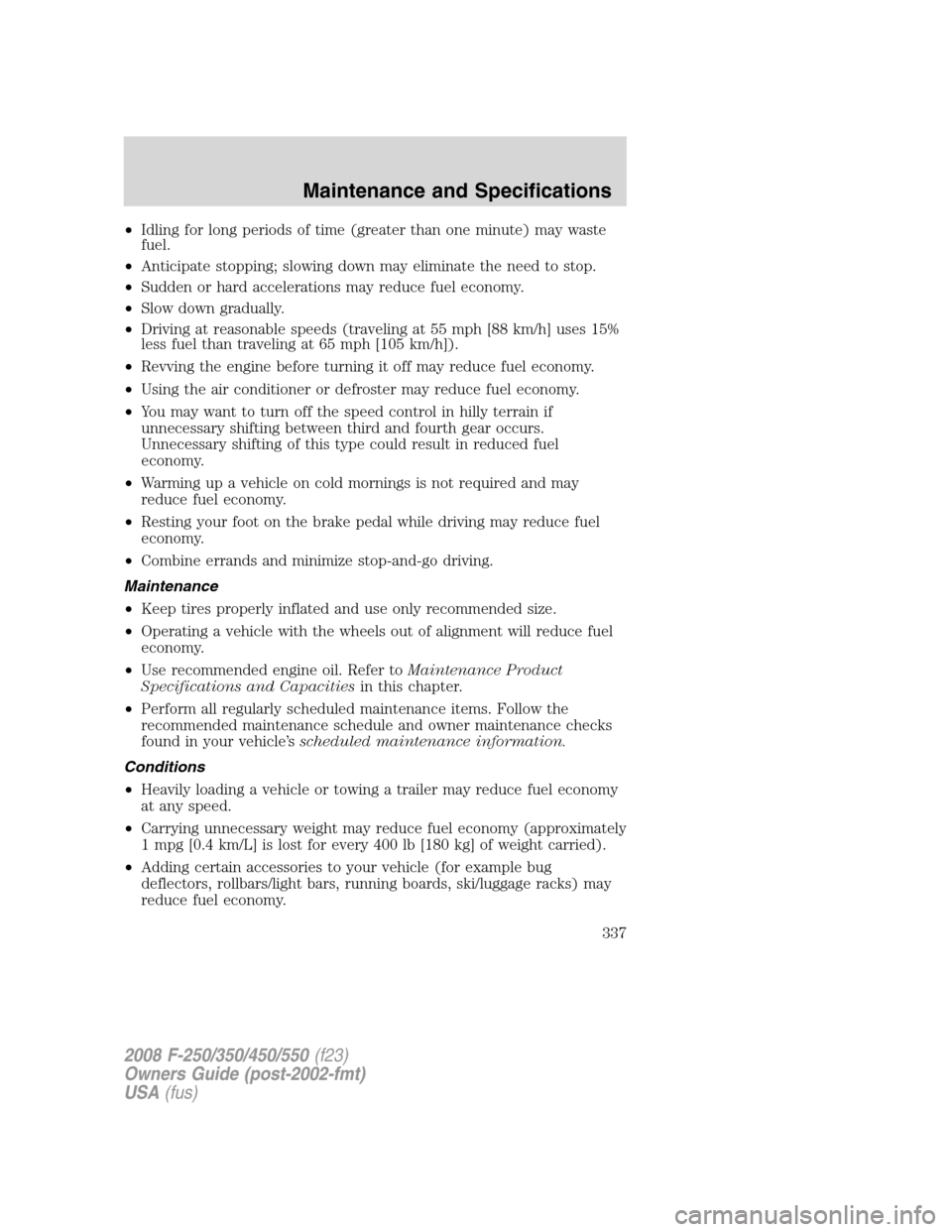Page 289 of 368

Stowing the flat/spare tire
Note:Failure to follow spare tire stowage instructions may result in
failure of cable or loss of spare tire.
1. Lay the tire on the ground with the valve stem facing in the direction
specified on the Tire Changing Instructions located in the glove box.
2. Slide the wheel partially under the vehicle and install the retainer
through the wheel center. Pull on the cable to align the components at
the end of the cable.
3. Turn the jack handle clockwise until the tire is raised to its stowed
position underneath the vehicle. The effort to turn the jack handle
increases significantly and the spare tire carrier ratchets or slips when
the tire is raised to the maximum tightness. Tighten to the best of your
ability, to the point where the ratchet/slip occurs, if possible. The spare
tire carrier will not allow you to overtighten. If the spare tire carrier
ratchets or slips with little effort, take the vehicle to your authorized
dealer for assistance at your earliest convenience.
4. Check that the tire lies flat against the frame and is properly
tightened. Try to push or pull, then turn the tire to be sure it will not
move. Loosen and retighten, if necessary. Failure to properly stow the
spare tire may result in failure of the winch cable and loss of the tire.
5. Repeat this tightness check procedure when servicing the spare tire
pressure (every six months, perscheduled maintenance information),
or at any time that the spare tire is disturbed through service of other
components.
6. If removed, install the spare tire lock (if equipped) into the bumper
drive tube with the spare tire lock key (if equipped) and jack handle.
WHEEL LUG NUT TORQUE SPECIFICATIONS
On vehicles equipped with single rear wheels, retighten the lug nuts to
the specified torque at 500 miles (800 km) after any wheel disturbance
(tire rotation, changing a flat tire, wheel removal, etc.).
On vehicles equipped with dual rear wheels, retighten the wheel lug nuts
to the specified torque at 100 miles (160 km), and again at 500 miles
(800 km) of new vehicle operation and after any wheel disturbance (tire
rotation, changing a flat tire, wheel removal, etc.).
2008 F-250/350/450/550(f23)
Owners Guide (post-2002-fmt)
USA(fus)
Roadside Emergencies
289
Page 337 of 368

•Idling for long periods of time (greater than one minute) may waste
fuel.
•Anticipate stopping; slowing down may eliminate the need to stop.
•Sudden or hard accelerations may reduce fuel economy.
•Slow down gradually.
•Driving at reasonable speeds (traveling at 55 mph [88 km/h] uses 15%
less fuel than traveling at 65 mph [105 km/h]).
•Revving the engine before turning it off may reduce fuel economy.
•Using the air conditioner or defroster may reduce fuel economy.
•You may want to turn off the speed control in hilly terrain if
unnecessary shifting between third and fourth gear occurs.
Unnecessary shifting of this type could result in reduced fuel
economy.
•Warming up a vehicle on cold mornings is not required and may
reduce fuel economy.
•Resting your foot on the brake pedal while driving may reduce fuel
economy.
•Combine errands and minimize stop-and-go driving.
Maintenance
•Keep tires properly inflated and use only recommended size.
•Operating a vehicle with the wheels out of alignment will reduce fuel
economy.
•Use recommended engine oil. Refer toMaintenance Product
Specifications and Capacitiesin this chapter.
•Perform all regularly scheduled maintenance items. Follow the
recommended maintenance schedule and owner maintenance checks
found in your vehicle’sscheduled maintenance information.
Conditions
•Heavily loading a vehicle or towing a trailer may reduce fuel economy
at any speed.
•Carrying unnecessary weight may reduce fuel economy (approximately
1 mpg [0.4 km/L] is lost for every 400 lb [180 kg] of weight carried).
•Adding certain accessories to your vehicle (for example bug
deflectors, rollbars/light bars, running boards, ski/luggage racks) may
reduce fuel economy.
2008 F-250/350/450/550(f23)
Owners Guide (post-2002-fmt)
USA(fus)
Maintenance and Specifications
337
Page 365 of 368

fluid, checking and adding ....340
fluid, refill capacity ................352
Power Windows ...........................98
Preparing to drive
your vehicle ...............................239
R
Radio ................................22, 24, 30
Rear seat entertainment
system ..........................................43
Relays ........................................268
Remote entry system ...............141
illuminated entry ............144, 146
locking/unlocking doors .........136
Reverse sensing system ...........246
Roadside assistance ..................265
S
Safety Belt Maintenance ..........170
Safety belts (see Safety
restraints) ..........158, 160–162, 164
Safety defects,
reporting ............................304–305
Safety
restraints ...........158, 160–162, 164
Belt-Minder�...........................167
extension assembly ................170
for adults .................160–162, 164
for children .....................180–181
lap belt ....................................166
safety belt maintenance .........170
warning light and
chime ...............................166–167
Safety seats for children ..........184
Safety Compliance
Certification Label ....................357Satellite Radio Information ........40
Seat belts
(see Safety restraints) .............158
Seats ..........................................151
child safety seats ....................184
cleaning ...................................311
heated ........................................75
memory seat ...................142, 156
SecuriLock passive anti-theft
system ................................148–149
Servicing your vehicle ..............314
Setting the clock
AM/FM/CD .................................25
AM/FM/In-dash 6 CD ................31
Snowplowing .................8, 262–264
Spark plugs,
specifications .....................350, 356
Special notice ................................9
ambulance conversions ..............8
diesel-powered vehicles .............8
utility-type vehicles ....................8
Speed control ............................104
Starting your vehicle ........231–233
jump starting ..........................290
Steering wheel
controls ....................................107
tilting .........................................95
T
Tailgate ......................................131
Tilt steering wheel ......................95
Tires ...................................194–195
alignment ................................204
care ..........................................200
changing ..........................279, 282
checking the pressure ............199
inflating ...................................196
2008 F-250/350/450/550(f23)
Owners Guide (post-2002-fmt)
USA(fus)
Index
365